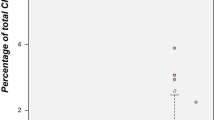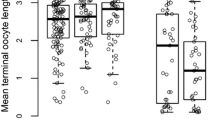Abstract
Primer pheromones play key roles in regulating division of labor, which is a fundamental and defining aspect of insect sociality. Primer pheromones are chemical messengers that transmit hormone-like messages among colony members; in recipients, these messages can either induce or suppress phenotypic caste differentiation. Here, we investigated soldier caste-derived chemicals as possible primer pheromones in the lower termite Reticulitermes flavipes, a species for which no primer pheromones have yet been identified. We determined that soldier head extracts (SHE), when provided to totipotent workers along with the insect morphogenetic juvenile hormone (JH), significantly enhanced soldier caste differentiation. When applied alone, however, SHE had no impacts on caste differentiation, survivorship, or any other aspect of worker biology. These findings support a function of soldier chemicals as primer pheromones that enhance the action of the endogenous JH. In accord with previous studies, γ-cadinene and the corresponding aldehyde, γ-cadinenal, were identified by gas chromatography–mass spectrometry and nuclear magnetic resonance analyses as the two most abundant components of R. flavipes SHE. Validative bioassays with commercially available cadinene confirmed activity. Several other terpenes, previously identified in R. flavipes soldiers, also were found to be active. These findings reveal a novel primer pheromone-like function for soldier-derived terpenes in termites and further suggest convergent evolution of terpene functions in enhancing JH-dependent soldier caste differentiation.



Similar content being viewed by others
References
Abe, T., Bignell, D. E., and Higashi, M. 2000. Termites: Evolution, sociality, symbioses, ecology. Kluwer Academic, Dordrecht, The Netherlands.
Bagnères, A. G., Clément, J. L., Blum, M. S., Severson, R. F., Joulie, C., and Lange, C. 1990. Cuticular hydrocarbons and defensive compounds of Reticulitermes flavipes (Kollar) and R. santonensis (Feytaud): Polymorphism and chemotaxonomy. J. Chem. Ecol. 16:3213–3244.
Brey, W. W., Edison, A. S., Nast, R. E., Rocca, J. R., Saha, S., and Withers, R. S. 2006. Design, construction and validation of a 1 mm triple resonance high-temperature superconducting probe for NMR. J. Mag. Res. 179:290–293.
Buchli, H. 1958. L’origine des castes et les poetntialities ontogeniques des termites europeens du genre Reticulitermes holmgren. Ann. Sci. Nat. Zool. 20:261–429.
Gilbert, L. I., Granger, N. A., and Roe, R. M. 2000. The juvenile hormones: Historical facts and speculations on future research directions. Insect. Biochem. Molec Biol. 30:617–644.
Gottlieb, H. E., Kotlyar, V., and Nudelman, A. M. 1997. NMR chemical shifts of common laboratory solvents as trace impurities. J. Org. Chem. 62:7512–7515.
Greenberg, S., and Tobe, S. S. 1984. Adaptation of a radiochemical assay for juvenile hormone biosynthesis to study caste differentiation in a primitive termite. J. Insect. Physiol. 31:347–352.
Hartfelder, K. 2000. Insect juvenile hormone: From “status quo” to high society. Braz. J. Med. Biol. Res. 33:157–177.
Heath, R. R., and Dueben, B. D. 1998. Analytical and preparative gas chromatography, pp. 85–126, in J. G. Millar, and K. F. Haynes (eds.). Methods in Chemical Ecology: Chemical Methods, vol. 1Kluwer, New York.
Henderson, G. R. 1998. Primer pheromones and possible soldier caste influences on the evolution of sociality in lower termites, pp. 314–330, in R. K. Vander Meer, M. D. Breed, K. E. Espelie, and M. L. Winston (eds.). Pheromone communication in social insectsWestview, Boulder, Colodaro.
Hojo, M., Morioka, M., Matsumoto, T., and Miura, T. 2005. Identification of soldier caste-specific protein in the frontal gland of nasute termite Nasuitetermes takasagoensis (Isoptera: Termitidae). Insect Biochem. Mol. Bio. 35:347–354.
Hojo, M., Matsumoto, T., and Miura, T. 2007. Cloning and expression of a geranylgeranyl diphosphate synthase gene: insights into the synthesis of termite defense secretion. Insect Mol. Bio. 16:121–131.
Kaiser, R., and Lamparsky, R. 1983. New carbonyl compounds in the high-boiling fraction of lavender oil. 1st communication. Helv. Chim. Acta 66:1835–1842.
Korb, J., Roux, E. A., and Lenz, M. 2003. Proximate factors influencing soldier development in the basal termite Cryptotermes secundus (Hill). Insectes Soc. 50:299–303.
Lainé, L. V., and Wright, D. J. 2003. The life cycle of Reticulitermes spp. (Isoptera: Rhinotermitidae): What do we know? Bull. Entomol. Res. 93:267–378.
Lefeuve, P., and Bordereau, C. 1984. Soldier formation regulated by a primer pheromone from the soldier frontal gland in a higher termite, Nasutitermes lujae. Proc. Natl. Acad. Sci. U.S.A. 81:7665–7668.
Lenz, M. 1976. The dependence of hormone effects in caste determination on external factors, pp. 73–90, in M. Lüscher (ed.). Phase and caste determination in insects. Endocrine aspectsPergamon, Oxford.
Lewis, J. L., and Forschler, B. T. 2004. Protist communities from four castes and three species of Reticulitermes (Isoptera: Rhinotermitidae). Ann. Entomol. Soc. Am. 97:1242–1251.
Mao, L., Henderson, G., Lui, Y., and Laine, R. A. 2005. Formosan subterranean termite (Isoptera: Rhinotermitidae) soldiers regulate juvenile hormone levels and caste differentiation in workers. Ann. Ent. Soc. Am. 98:340–345.
Matsumura, F., Coppel, H. C., and Tai, A. 1968. Isolation and identification of termite trail-following pheromone. Nature 219:963–964.
Miura, T. 2004. Proximate mechanisms and evolution of caste polyphenism in social insects: From sociality to genes. Ecol. Res. 19:141–148.
Miura, T., and Matsumoto, T. 2000. Soldier morphogenesis in a nasute termite: discovery of a disc-like structure forming a soldier nasus. Proc. Roy. Soc. Lond. B. Bio. 267:1185–1189.
Nelson, L. J., Cool, L. G., Forschler, B. T., and Haverty, M. I. 2001. Correspondence of soldier defense secretion mixtures with cuticular hydrocarbon phenotypes for chemotaxonomy of the termite genus Reticulitermes in North America. J. Chem. Ecol. 27:1449–1479.
Nelson, L. J., Cool, L. G., Solek, C. W., and Haverty, M. I. 2008. Cuticular hydrocarbons and soldier defense secretions of Reticulitermes in southern California: A critical analysis of the taxonomy on the genus in North America. J. Chem. Ecol. 34:1452–1475.
Nijhout, F. H. 2003. Development and evolution of adaptive polyphenisms. Evol. Dev. 5:9–18.
Nutting, W. L. 1990. Insect: Isoptera, pp. 997–1032, in D. L. Dindal (ed.). Soil Biology GuideWiley, New York, New York.
Okot-Kotber, B. M., Ujvary, I., Mollaaghababa, R., Szurdoki, F., Matolcsy, G., and Prestwich, G. D. 1991. Physiological influence on fenoxycarb pro-insecticides and soldier head extracts of various termite species on soldier differentiation in Reticulitermes flavipes (Isoptera). Sociobiology 19:77–89.
Okot-Kotber, B. M., Prestwich, G. D., Strambi, A., and Strambi, C. 1993. Changes in morphogenetic hormone titers in isolated workers of the termite Reticulitermes flavipes (Kollar). Gen. Comp. Endocrinol. 90:290–295.
Park, Y. I., and Raina, A. K. 2004. Juvenile hormone III titers and regulation of soldier caste in Coptotermes formosanus. J. Insect. Physiol. 50:561–566.
Park, Y. I., and Raina, A. K. 2005. Regulation of juvenile hormone titers by soldiers in the Formosan subterranean termite, Coptotermes formosanus. J. Insect. Physiol. 51:358–391.
Prestwich, G. D. 1983. Chemical systematics of termite exocrine secretions. Annu. Rev. Eco. Syst. 14:287–311.
Prestwich, G. D. 1984. Defense mechanisms of termites. Annu. Rev. Entomol. 29:201–232.
Quintana, A., Reinhard, J., Faure, P. U., Bagnères, A.-G., Mossiot, G., and Clément, J.-L. 2003. Interspecific variation in terpenoid composition on defensive secretions of European Reticulitermes termites. J. Chem. Ecol. 29:639–652.
Reinhard, J., Lacey, M. J., Ibarra, F., Schroeder, F. C., Kaib, M., and Lenz, M. 2002. Hydroquinone: a general phagostimulating pheromone in termites. J. Chem. Ecol. 28:1–14.
Scharf, M. E., Ratliff, C. R., Hoteling, J. T., Pittendrigh, B. R., and Bennett, G. W. 2003. Caste differentiation responses of two sympatric Reticulitermes termite species to juvenile hormone homologs and synthetic juvenoids in two laboratory assays. Insectes Soc. 50:346–354.
Scharf, M. E., Ratliff, C. R., Wu-scharf, D., Zhou, X., Pittendrigh, B. R., and Bennett, G. W. 2005. Effects of juvenile hormone III on Reticulitermes flavipes: changes in hemolymph protein composition and gene expression. Insect Biochem. Molec. 35:207–215.
Scharf, M. E., Buckspan, C. E., Grzymala, T. F., and Zhou, X. 2007. Regulation of polyphenic differentiation in the termite Reticulitermes flavipes by interaction of intrinsic and extrinsic factors. J. Exp. Biol. 210:171–179.
Schmelz, E. A., Alborn, H. T., and Tumlinson, J. H. 2001. The influence of intact-plant and excised-leaf bioassay designs on volicitin- and jasmonic acid-induced sesquiterpene volatile release in Zea mays. Planta 214:171–179.
Schmelz, E. A., Engelberth, J., Tumlinson, J. H., Block, A., and Alborn, H. T. 2004. The use of vapor phase extraction in metabolic profiling of phytohormones and other metabolites. Plant J. 39:790–808.
Szalanski, A. L., Austin, J. W., and Owens, C. B. 2003. Identification of Reticulitermes spp. (Isoptera: Reticulitermatidae) from South Central United States by PCR-RFLP. J. Econ. Entomol. 96:1514–1519.
Truman, J. W., and Riddiford, L. M. 1999. The origins of insect metamorphosis. Nature 401:447–452.
Vander meer, R. K., Breed, M. D., Espelie, K. E., and Winston, M. L. 1998. Pheromone communication in social insects. Westview, Boulder, Colorado.
Wilson, E. O. 1971. The insect societies. The Belknap press of Harvard University, Cambridge, Massachusetts.
Wilson, E. O., and Bossert, W. H. 1963. Chemical communication among animals. Recent Prog. Horm. Res. 19:673–716.
Zalkow, L. H., Howard, R. W., Gelbaum, L. T., Gordon, M. M., Deutsch, H. M., and Blum, M. S. 1981. Chemical ecology of Reticulitermes flavipes (Kollar) and R. virginicus (Banks) (Rhinotermitidae): Chemistry of the soldier cephalic secretions. J. Chem. Ecol. 7:717–731.
Zhou, X., Oi, F. M., and Scharf, M. E. 2006a. Social exploitation of hexamerin: RNAi reveals a major caste-regulatory factor in termites. Proc. Natl. Acad. Sci. U.S.A. 103:4499–4504.
Zhou, X., Tarver, M. R., Bennett, G. W., Oi, F. M., and Scharf, M. E. 2006b. Two hexamerin genes from the termite R. flavipes: sequence, evolution, expression and proposed function in caste regulation. Gene 376:47–58.
Zhou, X., Tarver, M. R., and Scharf, M. E. 2007. Hexamerin-based regulation of juvenile hormone-dependent gene expression underlies phenotypic plasticity in a social insect. Development 134:601–610.
Acknowledgments
We thank Drs. Nancy Denslow, Daniel Hahn, Mike Haverty, Larry Cool, and Faith Oi for helpful discussions; Caitlin Buckspan for bioassay assistance; Marsha Wheeler and Jody Green for review of the manuscript; and Dr. Robert J. Bartelt (USDA-ARS NCAUR, Peoria, IL, USA) for providing an authentic sample of (+)-γ-cadinene. The authors acknowledge the National Science Foundation for financial support through the User Program of the National High Magnetic Field Laboratory, which supported our NMR studies. The 600 MHz 1-mm HTS cryogenic NMR probe used in this work was developed through a collaboration among UF, the NHMFL, and Bruker BioSpin, which was funded by a National Institutes of Health grant (P41RR016105). This work was supported by USDA-CSREES-NRI grant no. 2007-35607-17777 to M.E.S.
Author information
Authors and Affiliations
Corresponding author
Electronic supplementary material
Below is the link to the electronic supplementary material
ESM 1
(DOC 219 KB)
Rights and permissions
About this article
Cite this article
Tarver, M.R., Schmelz, E.A., Rocca, J.R. et al. Effects of Soldier-Derived Terpenes on Soldier Caste Differentiation in the Termite Reticulitermes flavipes . J Chem Ecol 35, 256–264 (2009). https://doi.org/10.1007/s10886-009-9594-8
Received:
Revised:
Accepted:
Published:
Issue Date:
DOI: https://doi.org/10.1007/s10886-009-9594-8




